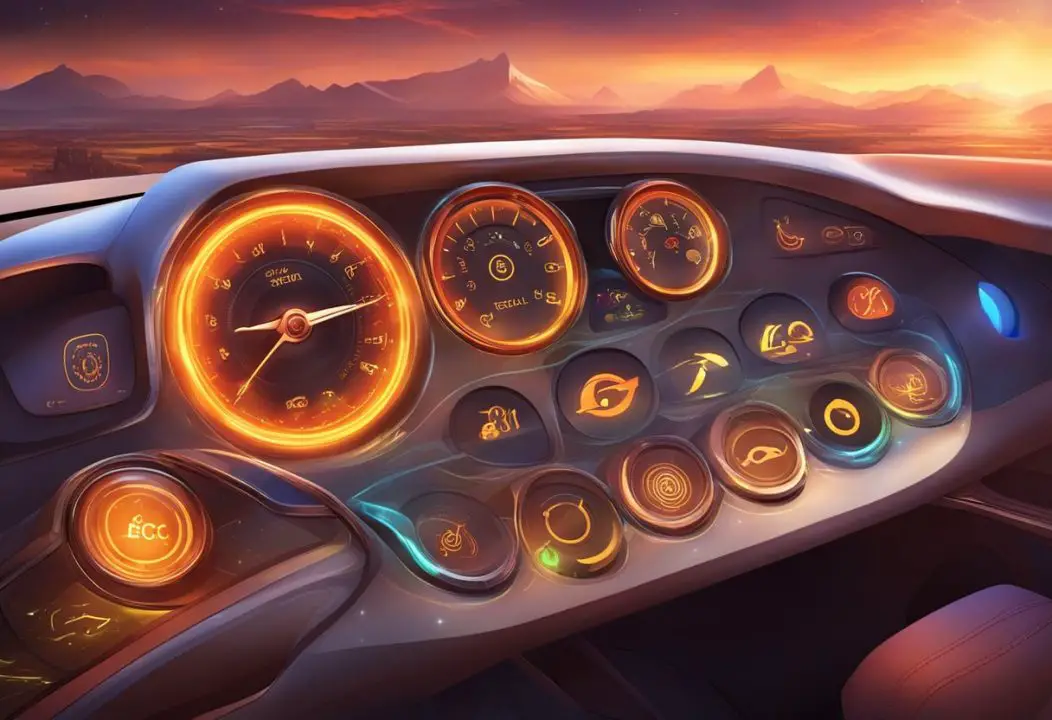Vehicle owners are always looking for ways to save money on gas and reduce their carbon footprint, and one way to do this is by utilizing the Eco mode feature in modern vehicles. Eco mode is designed to maximize fuel efficiency by optimizing the engine and transmission to adjust performance and shifting patterns, resulting in reduced fuel consumption. When used correctly, Eco mode can help drivers save money on gas and reduce their environmental impact.
Need tools for your project? Toolbox, a tool rental marketplace, might be worth a look.

Understanding Eco mode is essential to maximize its benefits. This mode instructs the engine computer to reduce throttle response and shift the transmission into higher gears faster, resulting in smoother acceleration and reduced fuel consumption. While it may reduce the engine’s power output and torque delivery, it can save up to 10% of fuel consumption when used correctly. However, it is essential to know when to use Eco mode to maximize its benefits, as it may not be suitable for all driving conditions.
Key Takeaways
- Eco mode is a feature in modern vehicles that maximizes fuel efficiency by optimizing engine and transmission performance.
- When used correctly, Eco mode can save up to 10% of fuel consumption.
- Knowing when to use Eco mode is essential to maximize its benefits.
Understanding Eco Mode
The Basics of Eco Mode
Eco mode is a feature in many modern vehicles that is designed to maximize fuel efficiency. When engaged, Eco mode can help drivers save money on gas and reduce their carbon footprint. In Eco mode, the vehicle’s engine and transmission work together to optimize fuel consumption. This is achieved by adjusting the engine’s performance and shifting the automatic transmission at lower RPMs.
When activated, Eco mode instructs the engine computer to reduce throttle response and shift the transmission into higher gears faster to maximize fuel efficiency. It’s hard to say whether Eco mode saves significant amounts of fuel, but it is ideal for city driving because it reduces the vehicle’s acceleration and throttle response.
Eco mode is not a magic button that will instantly save fuel. Its true value rests in its ability to encourage frugal driving behavior that can make a difference. When used correctly, Eco mode can reduce fuel consumption by up to 10%. However, it’s important to note that using Eco mode may also reduce the engine’s power output and torque delivery.
Eco Mode Versus Other Driving Modes
Eco mode is just one of several driving modes available in modern vehicles. Other modes include Sport mode, Normal mode, and Comfort mode. Each mode is designed to provide a different driving experience.
Sport mode, for example, is designed to provide a more aggressive driving experience. It increases throttle response and shifts gears at higher RPMs, which can improve acceleration and performance. Normal mode is a balanced mode that provides a comfortable driving experience. Comfort mode is designed to provide a smoother ride by adjusting the suspension and transmission settings.
Compared to these modes, Eco mode is designed to prioritize fuel economy over performance. It reduces the vehicle’s acceleration and throttle response to maximize fuel efficiency. While it may not provide the same level of performance as Sport mode, it can be a more practical option for drivers who want to save money on gas.
Benefits of Using Eco Mode
Modern vehicles come equipped with various features that aim to improve their fuel efficiency and reduce their environmental impact. One such feature is Eco Mode, which is designed to maximize efficiency and reduce fuel consumption. In this section, we will explore the benefits of using Eco Mode in your vehicle.
Fuel Economy and Savings
One of the primary benefits of using Eco Mode is improved fuel efficiency. By adjusting the engine’s performance, Eco Mode can help you get more miles per gallon. This is because the mode prioritizes fuel economy over performance, resulting in a more conservative use of fuel. If you’re looking to save money on gas, Eco Mode can be an excellent tool to help you achieve that goal. By reducing fuel consumption, Eco Mode can help you save money on gas prices and reduce your overall fuel expenses.
Reduced Emissions and Environmental Impact
Another benefit of using Eco Mode is reduced emissions and environmental impact. Eco Mode is designed to reduce fuel consumption and optimize the vehicle’s energy usage, resulting in reduced emissions and a smaller environmental footprint. By using Eco Mode, you can help reduce your vehicle’s carbon footprint and contribute to a cleaner and more sustainable environment.
Overall, Eco Mode is an excellent feature for drivers who are looking to maximize their vehicle’s fuel efficiency and reduce their environmental impact. By using Eco Mode, you can save money on gas, reduce fuel consumption, and help protect the environment.
When to Use Eco Mode

Eco mode is a useful feature in modern vehicles that can help drivers save money on gas and reduce their carbon footprint. However, it’s important to use it correctly to achieve the best results. Here are some tips on when to use eco mode:
City Driving Versus Highway Driving
Eco mode is most effective in city driving conditions, where stop-and-go traffic is common. In this type of driving, eco mode reduces the throttle response and shifts gears at lower RPMs, which can help you save fuel. On the other hand, in highway driving conditions, eco mode may not be as effective. This is because the vehicle is already operating at a steady speed, and reducing the throttle response may not have as much of an impact on fuel efficiency.
Optimizing Performance and Efficiency
To optimize performance and efficiency when using eco mode, it’s important to pay attention to driving conditions. For example, if you’re in heavy traffic, it’s a good idea to use eco mode to reduce fuel consumption. Similarly, if you’re driving at a lower speed, eco mode can help you save fuel by reducing the engine’s power output and torque delivery.
However, it’s important to note that eco mode may not be suitable for all driving conditions. For example, if you need to accelerate quickly, eco mode may not be the best option. This is because it reduces the engine’s performance, which can make it harder to accelerate quickly.
Overall, eco mode is a useful feature that can help drivers save money on gas and reduce their carbon footprint. However, it’s important to use it correctly and pay attention to driving conditions to achieve the best results.
Eco Mode in Different Vehicle Types

Eco mode is a feature that is now available in many modern vehicles, including hybrids, electric vehicles, and conventional gasoline vehicles. This feature is designed to maximize fuel efficiency by optimizing the engine’s performance and shifting patterns.
Hybrids and Electric Vehicles
Hybrids and electric vehicles (EVs) have a unique advantage when it comes to eco mode. In these vehicles, eco mode is designed to conserve energy and extend the range of the battery. When eco mode is engaged, the vehicle’s computer system will adjust the throttle response and shift patterns to reduce energy consumption.
In addition to eco mode, hybrids and EVs also have regenerative braking systems that capture energy from the brakes and store it in the battery. This feature helps to recharge the battery and extend the vehicle’s range.
Conventional Gasoline Vehicles
Eco mode is also available in conventional gasoline vehicles, but its effectiveness may vary depending on the vehicle’s make and model. In general, eco mode in gasoline vehicles is designed to improve fuel efficiency by adjusting the engine’s performance and shifting patterns.
Some manufacturers, such as Toyota and Lexus, have developed eco mode systems that are specifically designed for their vehicles. These systems may include features such as public charging stations and battery management systems to help improve fuel efficiency.
It is important to note that eco mode may not be effective in all driving conditions. For example, towing heavy loads or driving on steep inclines may require the vehicle to operate in a higher performance mode.
Overall, eco mode is a useful feature that can help drivers save money on gas and reduce their carbon footprint. However, it is important to understand how eco mode works and when it is most effective in order to get the most out of this feature.
Maximizing the Benefits of Eco Mode

Eco Mode is a feature found in many modern vehicles that can help drivers save on fuel costs and reduce their carbon footprint. To get the most out of Eco Mode, drivers need to adopt certain habits and perform regular maintenance on their vehicles.
Driving Habits and Techniques
The way a driver operates their vehicle can have a significant impact on fuel efficiency. Here are some tips for maximizing the benefits of Eco Mode:
- Gradual acceleration: Sudden acceleration can use up a lot of fuel. By gradually accelerating, drivers can reduce their fuel consumption and get more miles per gallon.
- Coasting: When approaching a red light or stop sign, drivers can take their foot off the accelerator and coast to a stop. This can save fuel and reduce wear and tear on the brakes.
- Air conditioning: Using the air conditioning can increase fuel consumption. Drivers can reduce the amount of time they use the air conditioning by rolling down the windows or using the fan instead.
Vehicle Maintenance and Settings
Maintaining a vehicle properly can also help drivers get the most out of Eco Mode. Here are some tips for maintaining a vehicle:
- Tire pressure: Keeping tires properly inflated can reduce rolling resistance and improve fuel efficiency. Drivers should check their tire pressure regularly and inflate them to the manufacturer’s recommended level.
- Vehicle settings: Some vehicles have settings that can be adjusted to improve fuel efficiency. Drivers should consult their owner’s manual to see if their vehicle has any such settings.
- Regenerative braking: Vehicles with regenerative braking can capture energy that would otherwise be lost during braking. This can improve fuel efficiency and extend the vehicle’s range.
By adopting these habits and performing regular maintenance, drivers can maximize the benefits of Eco Mode and save money on fuel costs.
Technological Advances in Eco Mode

Eco mode is a driving mode that is becoming increasingly popular in modern vehicles. It is a mode that prioritizes fuel efficiency and eco-friendliness over performance. This section will explore the technological advances that have been made in eco mode, including software and automation, and the future of eco-friendly driving.
Software and Automation
Modern vehicles are equipped with advanced software that helps drivers to maximize fuel efficiency. This software can automatically adjust the throttle response and shift gears at lower RPMs, which can help to save fuel. In addition, many vehicles are equipped with cruise control systems that can help to maintain a steady speed and reduce fuel consumption.
One of the most significant advances in eco mode technology is the development of automatic transmission systems. These systems can shift gears more efficiently than a human driver, which can help to maximize fuel efficiency. Some automakers have also developed one-pedal driving systems that allow drivers to accelerate and decelerate using only the accelerator pedal, which can further improve fuel efficiency.
Future of Eco-Friendly Driving
As the world becomes more focused on eco-friendliness, automakers are investing in new technologies that can help to reduce emissions and improve fuel efficiency. One of the most promising technologies is electric vehicles (EVs). EVs are powered by rechargeable batteries and produce zero emissions. They are also becoming increasingly affordable and practical for everyday use.
Another area of innovation in eco-friendly driving is the development of hydrogen fuel cell vehicles. These vehicles use hydrogen as a fuel source and produce only water as a byproduct. While they are still in the early stages of development, they have the potential to revolutionize the automotive industry.
In conclusion, technological advances in eco mode are helping drivers to maximize fuel efficiency and reduce emissions. From software and automation to the future of eco-friendly driving, automakers are investing in new technologies that are making driving more eco-friendly and sustainable.
Common Questions and Misconceptions

Eco Mode Myths Debunked
There are several misconceptions surrounding the use of eco mode in vehicles. One common myth is that eco mode makes the car sluggish and slow to accelerate. In reality, eco mode simply adjusts the throttle response to be more gradual, which can actually lead to a smoother and more fuel-efficient driving experience.
Another misconception is that eco mode is only useful for long highway drives. While it’s true that eco mode can help maximize fuel efficiency on the highway, it can also be useful in stop-and-go traffic or during short trips around town. In fact, using eco mode in these situations can help conserve fuel and reduce emissions.
Tips for First-Time Eco Mode Users
For drivers who are new to eco mode, there are a few tips to keep in mind. Firstly, it’s important to remember that eco mode is not a magic button that will instantly save fuel. Rather, it’s a tool that can help encourage more efficient driving habits.
One tip for first-time eco mode users is to forget about the lead foot. In eco mode, it’s important to accelerate gradually and avoid sudden bursts of speed. This can help conserve fuel and reduce emissions.
Another tip is to use accessories wisely. Using features such as heating, air conditioning, and entertainment systems can lower fuel economy on all vehicles, but they can have a greater effect on eco mode. So, keep that in mind when trying to maximize fuel economy or electric range.
In conclusion, eco mode can be a useful tool for drivers looking to maximize fuel efficiency and reduce emissions. By understanding common myths and misconceptions and following a few simple tips, drivers can make the most of this feature and enjoy a more fuel-efficient driving experience.
Frequently Asked Questions
How does Eco Mode affect vehicle performance?
When Eco Mode is activated, the vehicle’s engine and transmission work together to optimize fuel consumption. This is achieved by adjusting the engine’s performance and shifting gears earlier to reduce fuel consumption. As a result, the vehicle’s acceleration and throttle response are reduced, which can affect its overall performance.
Can using Eco Mode improve my car’s fuel efficiency?
Yes, using Eco Mode can improve your car’s fuel efficiency. By reducing the vehicle’s acceleration and throttle response, Eco Mode helps to optimize fuel consumption and reduce the amount of fuel used while driving. However, the amount of fuel saved will vary depending on driving conditions and driving habits.
What are the potential downsides of using Eco Mode regularly?
One potential downside of using Eco Mode regularly is that it can affect the vehicle’s overall performance. Since Eco Mode reduces the vehicle’s acceleration and throttle response, it may not be suitable for drivers who prefer a more responsive driving experience. Additionally, using Eco Mode regularly may cause the engine to wear out faster due to the increased strain on the engine.
How does Eco Mode differ from Power Mode in terms of driving experience?
Eco Mode is designed to optimize fuel consumption by reducing the vehicle’s acceleration and throttle response. On the other hand, Power Mode is designed to provide a more responsive driving experience by increasing the vehicle’s acceleration and throttle response. As a result, the driving experience in Power Mode is typically more aggressive than in Eco Mode.
Is Eco Mode suitable for all driving conditions?
Eco Mode is most suitable for city driving conditions where stop-and-go traffic is common. Since Eco Mode reduces the vehicle’s acceleration and throttle response, it can help to optimize fuel consumption in urban areas where traffic is slow-moving and congested. However, it may not be suitable for highway driving or other driving conditions where a more responsive driving experience is required.
In what situations is it best to avoid using Eco Mode?
It is best to avoid using Eco Mode in situations where a more responsive driving experience is required. For example, when merging onto a highway or passing another vehicle, Eco Mode may not provide the necessary acceleration and throttle response. Additionally, Eco Mode may not be suitable for driving in hilly or mountainous terrain where the vehicle may require more power to climb steep hills.